Abstract
The β-ketoacyl CoA synthase encoded by the KCS genes is a rate-limiting enzyme for the synthesis of very-long-chain fatty acid (VLCFA), which catalyzes the VLCFA elongation. Yellow horn (Xanthoceras sorbifolium) is a horticultural tree species known for its kernel oil, which has strong resistance to drought, cold, high temperature, and saline-alkali. The conserved domain FAE1-CUT1-RPPA and ACP-syn-III_C of the KCS gene family were used to search the KCS sequences across the whole genomic sequence of yellow horn; a total of 20 XsKCS genes were identified and divided into four subfamilies. The conserved motif and transmembrane structure analysis revealed that most XsKCSs had a conserved transmembrane domain except XsKCS10 and XsKCS20. The prediction of cis-acting elements of XsKCS genes showed that XsKCS genes contained many stress and hormone response elements, such as ABRE, MBS, and LTR. Furthermore, XsKCS genes exhibited differential expression profiles under abiotic stress and stress-related hormone treatment conditions. Transcriptomic data showed that XsKCS1, XsKCS11, and XsKCS17 had higher expression in yellow horn with high leaf cuticular wax, indicating that they may function in the cuticular wax accumulation and drought response. This study laid a foundation for further functional verification of XsKCS genes in yellow horn stress response.
1. Introduction
VLCFA (very long chain fatty acid) is a fatty acid with more than 18 carbon atoms in the organism. It involves the biosynthesis of wax precursors in the plant cuticle, which is the first barrier to plant self-protection [1]. The VLCFAs are catalyzed by a multienzyme complex localized on the endoplasmic reticulum, which consists of β-keto-CoA synthase (KCS), 3-keto-CoA reductase (KCR), 3-hydroxyacyl-CoA dehydratase (HCD), and enoyl-CoA reductase (ECR) [2,3]. Among them, the KCS enzyme has a strict substrate specificity and is a key rate-limiting enzyme for the synthesis of VLCFAs in organisms [2].
The type and quantity of the KCS gene family vary greatly among species [4]. A total of 13 KCS genes from Atalantia buxifolia [5], 28 KCS genes from apple [6], 58 KCS genes from Gossypium hirsutum [7] were identified. In Arabidopsis thaliana (A. thaliana), the KCS gene family has 21 members, which are divided into four subgroups: FAE1, KCS1, FDH, and CER6 [8]. Many KCS genes in various species were cloned and analyzed. FAE1/KCS18 (At4g34520) is the first KCS gene cloned from A. thaliana, which is only expressed in seeds and catalyzes the synthesis of C20 and C22 fatty acids to store lipids [9]. FDH/KCS10 (At2g26250) participates in the synthesis of VLCFAs in epidermal cells and plays a crucial role in preventing the fusions of epidermal cells in ectopic organs during vegetative development [10]. In addition, KCS genes were found to be involved in wax accumulation. For example, KCS1 (At1g01120) is constitutively expressed in Arabidopsis, and the complete loss of its function led to a decrease in the alcohol and aldehyde content of C26 and C30 in wax [11]. CER6/CUT1 (At1g68530) is involved in the synthesis of fatty acids above C26 and further synthesizes plant cuticle waxes [12], and in rice, two KCS genes, WSL1 and ONI1, are found to function in the leaf cuticular wax biosynthesis and the normal development of shoots [13].
The yellow horn (Xanthoceras sorbifolia) belongs to the Sapindaceae family and is a woody oil tree species native to northwestern China. As an endemic economic species, the yellow horn was widely used for conserving soil and water due to its capacity to survive in arid, saline, alkaline land and in extreme temperatures even below −40 °C [14]. The oil produced from its seed kernel contained 85% to 93% unsaturated fatty acids (37.1% to 46.2% linoleic acid and 28.6% to 37.1% oleic acid) and nearly 3.04% nervous acid [15]. Affected by geographical distribution, the shortage of water resources is one of the important limiting factors for its growth and yield.
The epidermal wax layer plays an important role in plant resistance to stress, especially drought stress. One KCS gene was differently expressed in yellow horn with different leaf wax thickness and showed a coexpression correlation with some transcription factors (e.g., MYB3) [16]. In this study, in order to further explore the role of KCS genes in the resistance response of yellow horn, bioinformatics methods were used to identify the members of the KCS gene family of yellow horn and the tissue expression patterns and expression level under abiotic stress were analyzed. The research can help us better understand the KCS family and provide new insights into breeding the high drought-resistant yellow horn.
2. Materials and Methods
2.1. Genome-Wide Identification of KCS Genes in Yellow Horn
In order to identify the KCS genes in the yellow horn genome, the HMM model of the KCS gene family (PF08392 and PF08541) was downloaded from the Pfam database (http://pfam-legacy.xfam.org/, accessed on 1 March 2022) [17]. The HMM-Search program of HMMER (ver3.3.2) (http://hmmer.org/, accessed on 2 March 2022) was used to retrieve and obtain the KCS sequences with these structural domains from the yellow horn genome, and “E-value” was set to 10−6 [18]. In addition, 21 Arabidopsis KCS protein sequences were used for BLASTP comparison with the yellow horn protein database, and the “E-values” less than 10−5 were screened. After integrating the results of HMM and BLASTP searches, the KCS protein sequences were submitted to CD-search (https://www.ncbi.nlm.nih.gov/Structure/cdd/wrpsb.cgi, accessed on 5 March 2022) [19] and SMART server (https://smart.embl-heidelberg.de/, accessed on 5 March 2022) to exclude the sequences with “E-values” higher than 1 × 10−5 for ACP-syn-III-C (PF08392) structural domain and FAE1-CUT1-RppA (PF08541) structural domain.
2.2. Physicochemical Properties, Subcellular Localization and Transmembrane Alpha Helix
In order to explore the physicochemical properties of the XsKCS protein, relative molecular mass (MW) and protein isoelectric point (pI) were predicted using the ProtParam tool (https://web.expasy.org/protparam/, accessed on 10 March 2022). Meanwhile, the subcellular localization of XsKCS proteins was predicted using WoLF_PSORT online server (https://wolfpsort.hgc.jp/, accessed on 10 March 2022) [20]. The TMHMM (v2.0) (https://services.healthtech.dtu.dk/service.php?TMHMM-2.0, accessed on 13 March 2022) online tool was used to predict the transmembrane alpha helix of XsKCS proteins.
2.3. Phylogenetic Analyses of XsKCS Proteins
The protein sequences of XsKCS in Xanthoceras sorbifolia and A. thaliana were aligned using the ClustalW. A phylogenetic tree was constructed with the maximum likelihood method using MEGA 11.0 software [21]. The parameters for the phylogenetic tree were pairwise deletion 50%, LG+G model, and 1000 bootstrap replications.
2.4. Gene Structure and Motif Analysis of XsKCS Genes
In order to explore the structural features of the XsKCSs, the MEME tool (https://meme-suite.org/meme/doc/meme.html, accessed on 20 March 2022) was used to identify 10 conserved motifs in XsKCS family members. The TBtools (v1.098696) was used to display the gene structures and motifs [22].
2.5. Cis-Element Prediction for Promoters
The 2-kb upstream sequence of the XsKCS gene was selected as promoter region. The PlantCARE (https://bioinformatics.psb.ugent.be/webtools/plantcare/html/, accessed on 25 March 2022) was used to predict the regulatory elements [23]. TBtools (v1.098696) was used for visualizing the results of the analysis.
2.6. Chromosome Localization and Synteny Analysis
In the synteny analysis, all-against-all comparisons were performed in the yellow horn genome using BLASTP search with E-values less than 10−10 to obtain the information on gene pairs. In the intergroup synteny analysis, the genomes of Oryza sativa, Populus trichocarpa, Arabidopsis thaliana, and yellow horn were analyzed genome-wide comparison. Next, MCScanX in TBtools was employed based on the BLASTP results to analyze syntenic blocks and gene duplication events. A circular map of XsKCS gene pairs in the yellow horn genome was drawn using Circos (http://circos.ca/, accessed on 27 March 2022).
2.7. Plant Materials and Treatments
The four-week tissue culture seedlings of yellow horn were used for various stress and hormone treatments after two weeks of hydroponic culture. The vigorous and neat seedlings were treated with 15% PEG6000, 100 μmol L−1 abscisic acid (ABA), 150 mM NaCl, 0.05 mM L−1 jasmonic acid (JA), 0.1 mM L−1 salicylic acid (SA), 35 °C high temperature and 4 °C low temperature, respectively, and four seedlings per treatment were as biological repeats. The non-treated seedlings were cultivated under the same growing conditions and were used as the control. The whole seedling was taken for the XsKCS gene expression analysis, and the samples were collected at 4, 12, and 24 h. The samples were immediately frozen in liquid nitrogen and stored at −80 °C. The four-week tissue culture seedlings of yellow horn after 3 weeks of matrix culture were used for the tissue-specific analysis of XsKCS gene expression.
2.8. Quantitative Real-Time (qRT)-PCR Analysis
The total RNA of yellow horn was extracted using the Polysaccharide polyphenol RNAprep Pure Kit (Tiangen Biotech, Beijing, China), and then cDNAs were synthesized from total RNA using the PrimeScript RT Reagent kit (Takara, Dalian, China). The XsACTIN gene (EVM0013888.1) was used as a reference, and the primers for qRT-PCR of XsKCS genes were designed according to their CDS sequences using Primer Premier (v5.0) software (Table S1). QRT-PCR was performed on LightCycler 480II real-time PCR system (Roche, Indianapolis, IN, USA) with KAPA SYBR FAST qPCR Master Mix (Kapa Biosystems, Wilmington, MA, USA), and each analysis contained three technical repetitions and three biological replicates. The relative expression of XsKCS genes was analyzed with the 2−ΔΔCT method. A heatmap was constructed according to the expression matrix of XsKCS genes.
2.9. RNA Sequencing and RNA-Seq Data Analysis
The same growth trend seedlings of yellow horn (‘Zhongshi4’ and the control) with different content of leaf epicuticular wax were used for transcriptome analysis [24]. Total RNA was extracted from the yellow horn seedlings. RNA-Seq libraries were constructed with high-quality RNAs and sequenced by Illumina paired-end sequencing technology on MGI-SEQ platform. The yellow horn genome in the NCBI database (accession number: PRJNA483857) was used as the reference genome. The differentially expressed genes (DEGs) were screened with |log2Fold Change|≥ 1 and false discovery rate (FDR) <0.01.
3. Results
3.1. Identification of KCS Genes in Yellow Horn, Physicochemical Properties and Subcellular Localization
A total of 20 KCS genes from the yellow horn genome were identified using HMM and BLASTP, and they were named from XsKCS1 to XsKCS19 based on the position on the chromosome (Table 1), and the gene not mapped on the chromosome was denoted as XsKCS20. The length of XsKCS proteins ranged from 395 (XsKCS20) to 531 (XsKCS11) amino acids, with an average length of 480 residues. Physicochemical property analysis showed that the relative molecular weight (MW) of XsKCS ranged from 40.30 kDa (XsKCS20) to 60.63 kDa (XsKCS11), and the isoelectric point (pI) of XsKCS ranged from 8.82 (XsKCS2) to 9.43 (XsKCS7), with all pI > 7 (Table 1). The subcellular localization results indicated that most of the XsKCS proteins were located in the plasma membrane, except for XsKCS5 and XsKCS19, XsKCS14 and XsKCS18, XsKCS10 and XsKCS20, which are expected to be localized in the chloroplast, endoplasmic reticulum and cytoplasmic, respectively (Table 1).

Table 1.
Physicochemical properties and subcellular localization of XsKCS genes.
3.2. Phylogenetic Analysis of the XsKCS Family
In order to investigate the evolutionary relationships of XsKCS proteins, the KCS protein sequences from yellow horn and Arabidopsis were used to construct a phylogenetic tree using the maximum likelihood method (Figure 1). The XsKCS proteins were clustered into four subfamilies (KCS1-like, FDH-like, FAE1-like, and CER6) according to the classification of AtKCS proteins [8]. The KCS1-like and FDH-like subgroups were larger subfamilies with eight and nine XsKCS genes, respectively, whereas FAE1-like and CER6 subgroups have fewer members, only containing one and two XsKCS genes, respectively.
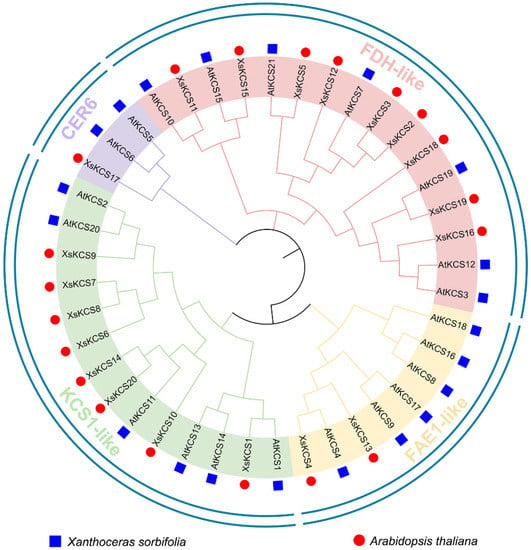
Figure 1.
Phylogenetic tree of XsKCS genes family. The 41 predicted KCS proteins from Arabidopsis thaliana and Xanthoceras sorbifolia were aligned using ClustalW. Four subfamilies are represented by the different colored lines.
3.3. Conserved Motif and Gene Structure Analysis of XsKCS Genes
A total of 10 conserved motifs were identified in XsKCSs, ranging from 15 to 50 residues in length (Figure 2A). The number of motifs contained by different XsKCS proteins varied considerably. All XsKCS proteins contain motifs one, two, four, and five, which are essential in XsKCS and are conserved components of the FAE1-CUT1-RPPA (PF08541) or ACP-syn-III_C (PF08392) domains catalyzing biochemical reactions. Only XsKCS15, a member of the FDH-like subgroup, lacked motifs 7 and 10. In the KCS1-like subgroup, two members (XsKCS10 and XsKCS20) did not have motifs three and eight. The similarity of the conserved motif composition of XsKCSs is high, implying that a certain degree of functional redundancy may exist in the XsKCS family, and the evolution of XsKCS genes is relatively conservative in the yellow horn.
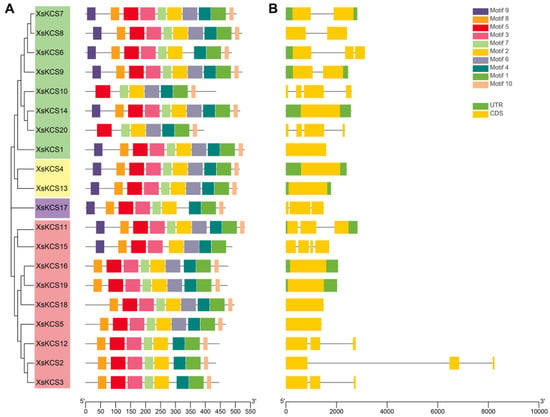
Figure 2.
Conserved motifs and exon/intron structure analysis. (A) The conserved motifs of XsKCS proteins. Black lines indicate the non-conserved sequences. Different colored boxes indicated the putative motifs. Each motif size can be estimated by the scale located at the bottom. (B) Exon/intron structure analysis of XsKCS genes. The black line refers to the introns. The sizes of exons or introns can be estimated by the scale at the bottom.
20 XsKCS genes had exons ranging from 0 to 3. Among the 20 XsKCS genes, eight XsKCS genes only have one exon (Figure 2B). In the FDH-like subgroup, XsKCS2 contains a longer intron sequence, and its CDS sequence is highly similar to that of XsKCS3 (Figure S1). In addition, 11 XsKCS genes lack the UTR region, XsKCS6 only has a 5′ UTR region, and 8 XsKCS genes have both a 5′ UTR and 3′ UTR region.
3.4. Transmembrane Alpha Helix of XsKCS Proteins
According to previous reports, the KCS gene family is a class of transmembrane proteins [25]. In order to further explore the transmembrane structure of XsKCS proteins, the TMHMM (v2.0) tool was used to predict the transmembrane alpha helix of XsKCS proteins (Figure 3). The results showed that most XsKCS proteins (13 proteins, 65%) had two transmembrane alpha helices; XsKCS4, XsKCS8, XsKCS11, and XsKCS15 had three transmembrane alpha helices; XsKCS12 had one transmembrane alpha helix. Surprisingly, XsKCS10 and XsKCS20 had no transmembrane alpha helix. Most of the transmembrane alpha-helices of XsKCS proteins are located in the N-terminal pre-100 bp, and only a few transmembrane alpha helices are located in the C-terminal pre-100 bp or sequence middle.
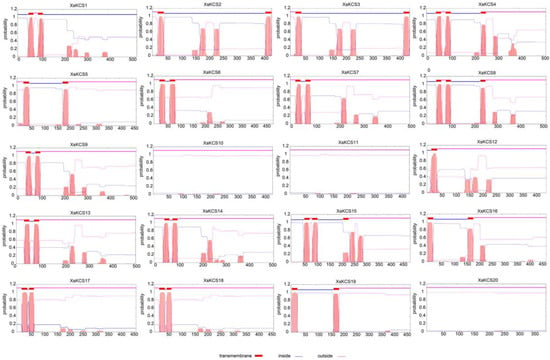
Figure 3.
Transmembrane alpha helix of XsKCS proteins. The red rectangles represent the transmembrane alpha helix, the blue thickened lines represent the amino acid in this segment that is located inside the membrane, the pink thickened lines represent the amino acid in this segment that is located outside the membrane, the scale on the left side indicates the probability of correct prediction.
3.5. Chromosomal Localization and Gene Duplication Analysis of XsKCS Gene Family
The chromosomal distributions of XsKCS genes were visualized according to the genomic position of 20 yellow horn KCS genes (Figure 4A); the 20 XsKCS genes were unevenly mapped on nine chromosomes. Chr3 contained eight XsKCS genes, accounting for 40%, while the other eight chromosomes contained only one to three XsKCS genes. In addition, The XsKCS20 gene mapped to a fragment of nucleic acid sequence that has not been assembled on the chromosome (ctg214). Notably, four adjacent XsKCS genes (XsKCS6, XsKCS7, XsKCS8, and XsKCS9) were found to be grouped together on the same chromosome and formed three tandem repeat gene pairs (XsKCS6/7, XsKCS7/8, and XsKCS8/9), suggesting that these KCS genes may have similar biological functions.
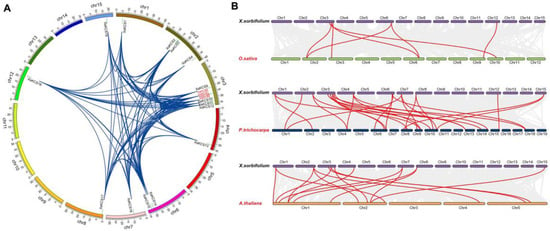
Figure 4.
Chromosomal distributions, synteny analysis within the yellow horn and between yellow horn and three representative plant species. (A) The chromosome distribution and chromosome relationship of the yellow horn XsKCS genes. The blue lines indicate the repeated pairs of XsKCS genes, and the red letters represent tandem repeats. (B) Synteny analysis between yellow horn (X. sorbifolium) and three representative plant species, O. sativa, P. trichocarpa and A. thaliana. The grey lines are indicative to the collinear blocks within yellow horn and other plants; the red lines refer to the syntenic XsKCS gene pairs.
In order to disclose the extension mechanism of the XsKCS gene family, we found by using the MCScanX method that 19 XsKCS genes formed 155 segmental gene duplication events within the yellow horn (Figure 4A). Fragment-duplicated genes were the most frequently found on Chr 3, followed by Chr 2 and Chr 6. To further analyze the evolution of the XsKCS gene in the plants, we constructed comparative syntenic maps of yellow horn and A. thaliana, O. sativa, and P. trichocarpa, respectively (Figure 4B). According to the syntenic maps, the number of segmental duplication events of KCS genes was 15 (A. thaliana), 7 (O. sativa), and 25 (P. trichocarpa), respectively. These results suggest that segmental replication events mainly catalyzed the evolution of the XsKCS genes in the yellow horn.
3.6. Analysis of Cis-Acting Regulatory Elements of the XsKCS Promoter
To explore the cis-regulatory elements in the promoter of the XsKCS gene, a 2000 bp nucleic acid sequence on the XsKCS gene start codon was downloaded and analyzed by submitting it to the PlantCARE server (Figure 5). Not surprisingly, we found many cis-acting elements in the promoter of the XsKCS gene that are involved in the corresponding plant hormone and stress responses. These elements belong to nine main categories: ABA, JA, SA, GA, IAA, light, low temperature, defense and stress, drought, and anaerobic. Among 20 XsKCS genes, XsKCS4, XsKCS9, XsKCS12, XsKCS14, XsKCS19, and XsKCS20 have more hormone and stress-related elements. Notably, there were more ABA response elements and light response elements than other response elements (Figure 5B).
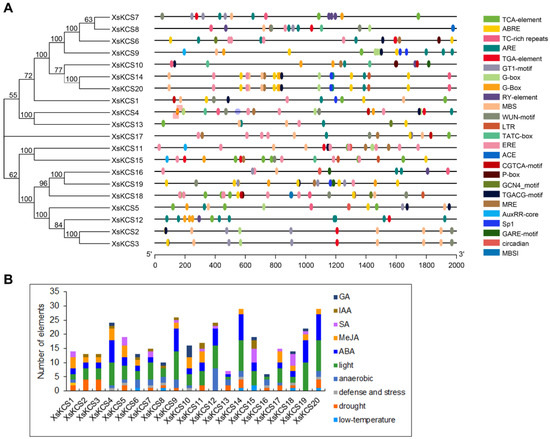
Figure 5.
Distribution of cis-acting regulatory elements of the XsKCS genes in yellow horn. (A) The cis-acting regulatory elements identified in 20 XsKCS genes. The different colored boxes represent different cis-acting regulatory elements. (B) The bar graphs of the numbers of different cis-elements. The similar cis-elements are exhibited with the same colors.
3.7. Expression Profiles of XsKCS Genes in Different Tissues of Yellow Horn
In order to investigate the biological functions of XsKCS genes in stress response, their expression levels were examined in the roots, stems, and leaves by qRT-PCR. As shown in Figure 6, XsKCS1, XsKCS4, XsKCS9, XsKCS11, XsKCS12, XsKCS13, XsKCS16, XsKCS17, and XsKCS18 exhibited higher expression levels in the roots, stems or leaves, especially in the leaves, while XsKCS18 was lowly expressed in the leaves. Conversely, XsKCS2/3, XsKCS7, XsKCS14, XsKCS15, XsKCS19, and XsKCS20 had lower expression levels, and XsKCS5 was not even detected in the roots, stems, and leaves. XsKCS6 was expressed at a relatively high level in the stem and XsKCS10 in the root. The tissue-based expression profiling of XsKCS genes suggested that XsKCSs show gene functional divergence in response to stress, except XsKCS5.
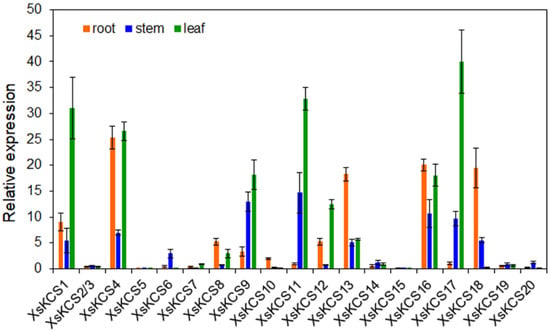
Figure 6.
The expression profiles of XsKCS genes in different tissue. Error bars indicate SD.
3.8. Expression Profile of XsKCS Genes under Abiotic Stress
To further explore the potential role of XsKCS genes in response to various stresses, we analyzed the transcriptional responses of XsKCS genes to salt, drought (PEG), high temperature, low temperature, ABA, JA, and SA treatments (Figure 7). The expression of most XsKCS genes were regulated by the four stresses and three hormones to varying degrees, except XsKCS5, which had no expression in the roots, stems, and leaves. XsKCS1, XsKCS4, and XsKCS18 showed upregulated expression under four stresses and three hormone treatments. The expression levels of XsKCS7, XsKCS9, XsKCS11, and XsKCS12 were inhibited under heat stress, while XsKCS7, XsKCS11, and XsKCS12 under cold stress were induced at 24 h. Most XsKCSs (except XsKCS15) were upregulated by drought and salt stress, especially XsKCS1, XsKCS9, and XsKCS18. The expression of XsKCS15 was only upregulated by the SA treatment and had no significant change under other treatments. Conversely, XsKCS14 showed downregulated expression under SA treatment but was induced under other treatments. Only XsKCS8 and XsKCS16 did not respond to the treatment of three hormones (ABA, JA, and SA). Based on the above results, we suggest that XsKCSs play an important role in coping with stress.
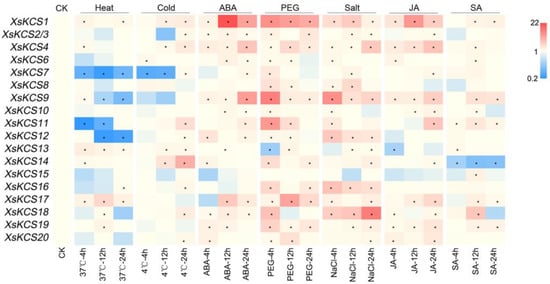
Figure 7.
The expression heat map of XsKCS genes under different stress treatments. Scale bar on the right represents the relative expression level of each gene detecting by qRT-PCR. * indicates significant differences at p < 0.05. The significance analysis was performed by SPSS 25 with one-way ANOVA and Duncan multiple comparison analysis.
3.9. Transcriptome Analysis of the Expression Patterns of XsKCS Genes in High-Wax Yellow Horn
In order to explore the role of XsKCS genes in the wax accumulation of yellow horn, the expression of XsKCSs in the leaves of the high-wax yellow horn (‘Zhongshi 4’) and the control were detected via RNA seq. The leaves of the yellow horn ‘Zhongshi 4’ have an obvious wax layer and more wax accumulation compared with the control (Figure 8). The expression levels of XsKCS genes were diverse, and two XsKCS genes (XsKCS10 and XsKCS15) were not detected expressed in the leaves of yellow horn ‘Zhongshi 4’ and the control (Table S2). A total of six XsKCSs (XsKCS2, XsKCS3, XsKCS5, XsKCS6, XsKCS18, and XsKCS20) showed low or no expression levels (FPKM < 1) in the samples. A total of six XsKCSs (XsKCS1, XsKCS4, XsKCS11, XsKCS12, XsKCS16, and XsKCS17) (FPKM > 10) were found to be highly expressed in yellow horn ‘Zhongshi 4’ and the control, particularly XsKCS17 (FPKM > 100). A total of four XsKCS genes (XsKCS1, XsKCS11, XsKCS16, and XsKCS17) showed higher expression levels in yellow horn ‘Zhongshi 4’ than those in the control, indicating that they may involve in the wax accumulation of yellow horn ‘Zhongshi 4’. While XsKCS7 and XsKCS8 had lower expression in yellow horn ‘Zhongshi 4’ than those in the control (Figure 9).
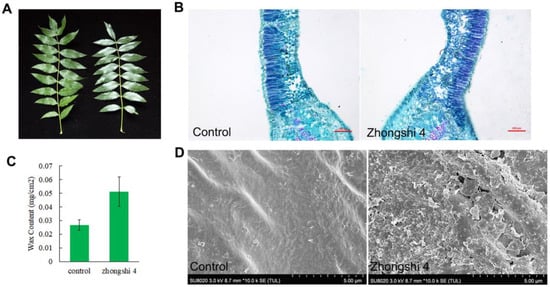
Figure 8.
The wax accumulation in the leaves of yellow horn. (A) Photographic image of the control (left) and ‘Zhongshi 4’ (right) leaves. (B) Anatomical structure characterization of the control and ‘Zhongshi 4’ leaves. (C) The wax content in the leaves of the control and ‘Zhongshi 4’. (D) Wax crystal morphology of the leaves of the control and ‘Zhongshi 4’ via scanning electron microscopy.
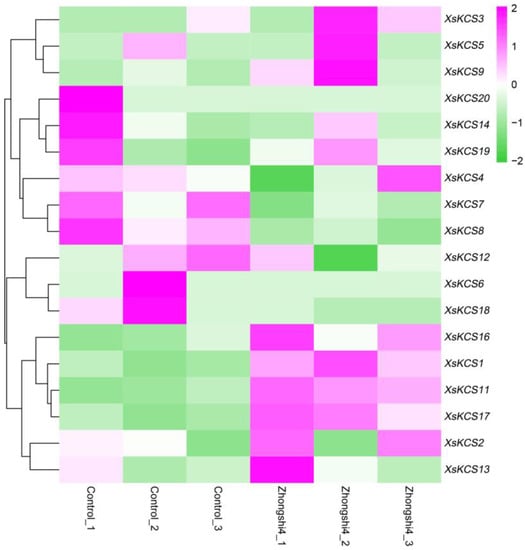
Figure 9.
The expression heat map of XsKCS genes in high-wax and low-wax yellow horn via transcriptome analysis. Scale bar on the right represents the expression level of XsKCS genes.
4. Discussion
The plant epidermal wax is a barrier between the plant and the environment and plays a key role in plant response to various biotic and abiotic stresses, such as drought and salinity [26]. VLCFA is an important precursor substance for the synthesis of plant cuticle waxes. KCS family genes, which encode the key restriction enzyme in the VLCFA synthesis pathway, have been identified in various plant species [4,27,28]. In this study, 20 XsKCS genes were identified in the yellow horn genome (Table 1). According to the AtKCS genes, all KCS proteins in yellow horn were classified into four groups: KCS1-like, FDH-like, FAE1-like, and CER6, similar to the previous classification of Arabidopsis (Figure 1) [8]. Unlike Arabidopsis, the FAE1-like group has only two members in the yellow horn (Figure 1).
The KCS gene family has been reported that is a class of transmembrane proteins [25]. In yellow horn, most XsKCS genes contain 1–3 transmembrane domains; the XsKCS genes belonging to the KCS1-like group all contain two N-terminal transmembrane domains, which is consistent with the previous study, except XsKCS10 and XsKCS20 (Figure 3) [2]. By comprehensive analysis of transmembrane structural domains and motifs, motif8 and motif9 are N-terminal transmembrane domains (Figure 2). Exon-intron structure analysis showed that 12 XsKCS genes in yellow horn contain 1–3 intron structures (Figure 2), while most KCS genes have one exon and no intron structure in Gossypium barbadense and barley [27,28], which might be associated with the diversification of their functions. Moreover, exon numbers can affect the expression of genes. It has been reported that genes with fewer exons are induced faster [29,30,31].
Tandem and segmental gene duplication events are the two main modes of gene family expansion [32,33]. Based on the tandem analysis of the XsKCS gene family, three tandem repeats and 155 fragment repeats were found in 19 XsKCS genes (Figure 4). It seems that segmental replication events have affected the KCS gene family in yellow horn and extended this gene family. Moreover, mutation, as well as some evolution events, might subject the regulatory site (upstream or downstream site) and coding site of new members of the gene family and affect their expression patterns and function [34,35]. There were some same collinear XsKCS gene pairs between the yellow horn and the other three species, suggesting that genes in these different species may perform similar functions.
Previous studies have demonstrated that KCS genes are involved in diverse stress response processes, such as drought, salt, and low-temperature [36,37,38]. Consistent with the expression patterns of AtKCS genes, most XsKCS genes were widely expressed and exhibited different expression levels in roots, stems, and leaves, which may be related to their multiple functions (Figure 6) [2]. Among them, XsKCS5, which is homologous to AtKCS21, had no expression in roots, stems, and leaves, speculating that it may be specifically expressed in flowers such as AtKCS21 [2]. Moreover, qRT-PCR assays and cis-element analysis indicated that most XsKCS genes were induced by salt, drought, low temperature, ABA, JA, and SA, especially drought and salt (Figure 7), suggesting their potential roles in the stress response of yellow horn.
Yellow horn is mainly distributed in the three northern regions of China, where water resources are scarce, and drought stress is one of the severe challenges for growth. Many KCS genes have been found to participate in regulating the tolerance to drought stress. For instance, the overexpression of CsKCS6 and MdKCS2 in Arabidopsis increased the cuticular wax accumulation and enhanced the tolerance to drought [37,39]. The treatment of ABA and drought strongly improved the expression of XsKCS1, XsKCS9, XsKCS11, and XsKCS17 in yellow horn (Figure 7), which might contribute to the improvement of tolerance to drought. In addition, KCS6/CER6, KCS1, KCS2, KCS20, KCS10, and KCS16 were reported to be involved in wax synthesis [10,11,40,41]. Here, XsKCS1, XsKCS11, XsKCS16, and XsKCS17 exhibited higher expression in yellow horn with a thick waxy layer. These results suggest that KCS genes may play a role in the wax accumulation and drought response in yellow horn, especially XsKCS1, XsKCS11, and XsKCS17. These findings revealed that XsKCS genes might be involved in resistance to stresses in yellow horn, especially drought and salt.
5. Conclusions
In this study, a total of 20 XsKCS genes were identified in yellow horn and divided into four groups. XsKCS family members have four conserved motifs, and most of them contain the transmembrane alpha helices. Gene duplication and segmental replication are important for the XsKCS evolution. In addition, the promoters of most XsKCS genes have stress-related elements, and the expression profiling of most XsKCS genes (except XsKCS15) was upregulated by drought and salt stresses. Transcriptome data and qRT-PCR analysis indicated that three candidate XsKCS genes were highly expressed in high-wax yellow horn and in drought-treated seedlings. The findings provide a foundation for future research on their functions under abiotic stresses.
Supplementary Materials
The following supporting information can be downloaded at: https://www.mdpi.com/article/10.3390/horticulturae9010025/s1, Figure S1 The CDS sequence alignment of XsKCS2 and XsKCS3. The navy blue bars show identical bases, the residues are different. Table S1 List of primers used for qRT-PCR; Table S2 The fpkm values of XsKCS genes in the transcriptome of yellow horn.
Author Contributions
X.L. and L.W.: Methodology, Conceptualization. X.L. and Y.Y.: Validation. X.L. and Z.Z.: Software, Formal analysis, Writing—Original Draft, Visualization. H.X. and Q.B.: Writing—Review and Editing. All authors have read and agreed to the published version of the manuscript.
Funding
This work was financially supported by the National Natural Science Foundation of China (31870594, 31901348) and the “Youth Top Talent project” of the “Ten Thousand Talents Program” of the state.
Data Availability Statement
The raw sequence data were deposited in the National Center for Biotechnology Information (NCBI), and the accession number is PRJNA910651.
Conflicts of Interest
The authors declare no conflict of interest.
References
- De Bigault Du Granrut, A.; Cacas, J.L. How Very-Long-Chain Fatty Acids Could Signal Stressful Conditions in Plants? Front. Plant Sci. 2016, 7, 1490. [Google Scholar] [CrossRef] [PubMed]
- Joubès, J.; Raffaele, S.; Bourdenx, B.; Garcia, C.; Laroche-Traineau, J.; Moreau, P.; Domergue, F.; Lessire, R. The VLCFA elongase gene family in Arabidopsis thaliana: Phylogenetic analysis, 3D modelling and expression profiling. Plant Mol. Biol. 2008, 67, 547–566. [Google Scholar] [CrossRef] [PubMed]
- Ni, Y.; Guo, Y.J. Progress in the study on genes encoding enzymes involved in biosynthesis of very long chain fatty acids and cuticular wax in plants. Hereditas 2008, 30, 561–567. [Google Scholar] [CrossRef] [PubMed]
- Guo, H.-S.; Zhang, Y.-M.; Sun, X.-Q.; Li, M.-M.; Hang, Y.-Y.; Xue, J.-Y. Evolution of the KCS gene family in plants: The history of gene duplication, sub/neofunctionalization and redundancy. Mol. Genet. Genom. 2016, 291, 739–752. [Google Scholar] [CrossRef] [PubMed]
- Yang, H.; Mei, W.; Wan, H.; Xu, R.; Cheng, Y. Comprehensive analysis of KCS gene family in Citrinae reveals the involvement of CsKCS2 and CsKCS11 in fruit cuticular wax synthesis at ripening. Plant Sci. 2021, 310, 110972. [Google Scholar] [CrossRef]
- Lian, X.-Y.; Wang, X.; Gao, H.-N.; Jiang, H.; Mao, K.; You, C.-X.; Li, Y.-Y.; Hao, Y.-J. Genome wide analysis and functional identification of MdKCS genes in apple. Plant Physiol. Biochem. 2021, 151, 299–312. [Google Scholar] [CrossRef]
- Xiao, G.-H.; Wang, K.; Huang, G.; Zhu, Y.-X. Genome-scale analysis of the cotton KCS gene family revealed a binary mode of action for gibberellin A regulated fiber growth. J. Integr. Plant Biol. 2016, 58, 577–589. [Google Scholar] [CrossRef]
- Costaglioli, P.; Joubès, J.; Garcia, C.; Stef, M.; Arveiler, B.; Lessire, R.; Garbay, B. Profiling candidate genes involved in wax biosynthesis in Arabidopsis thaliana by microarray analysis. Biochim. et Biophys. Acta (BBA)-Mol. Cell Biol. Lipids 2005, 1734, 247–258. [Google Scholar] [CrossRef]
- James, D.W., Jr.; Lim, E.; Keller, J.; Plooy, I.; Ralston, E.; Dooner, H.K. Directed tagging of the Arabidopsis FATTY ACID ELONGATION1 (FAE1) gene with the maize transposon activator. Plant Cell 1995, 7, 309–319. [Google Scholar] [CrossRef]
- Pruitt, R.E.; Vielle-Calzada, J.-P.; Ploense, S.E.; Grossniklaus, U.; Lolle, S.J. FIDDLEHEAD, a gene required to suppress epidermal cell interactions in Arabidopsis, encodes a putative lipid biosynthetic enzyme. Proc. Natl. Acad. Sci. USA 2000, 97, 1311–1316. [Google Scholar] [CrossRef]
- Todd, J.; Post-Beittenmiller, D.; Jaworski, J. KCS1encodes a fatty acid elongase 3-ketoacyl-CoA synthase affecting wax biosynthesis inArabidopsis thaliana. Plant J. 1999, 17, 119–130. [Google Scholar] [CrossRef] [PubMed]
- Fiebig, A.; Mayfield, J.A.; Miley, N.L.; Chau, S.; Fischer, R.L.; Preuss, D. Alterations in CER6, a Gene Identical to CUT1, Differentially Affect Long-Chain Lipid Content on the Surface of Pollen and Stems. Plant Cell 2000, 12, 2001–2008. [Google Scholar] [CrossRef] [PubMed]
- Lee, S.B.; Suh, M.C. Advances in the understanding of cuticular waxes in Arabidopsis thaliana and crop species. Plant Cell Rep. 2015, 34, 557–572. [Google Scholar] [CrossRef] [PubMed]
- Yu, H.; Fan, S.; Bi, Q.; Wang, S.; Hu, X.; Chen, M.; Wang, L. Seed morphology, oil content and fatty acid composition variability assessment in yellow horn (Xanthoceras sorbifolium Bunge) germplasm for optimum biodiesel production. Ind. Crops Prod. 2017, 97, 425–430. [Google Scholar] [CrossRef]
- Taylor, D.C.; Guo, Y.; Katavic, V.; Mietkiewska, E.; Francis, T.; Bettger, W. New Seed Oils for Improved Human and Animal Health: Genetic Manipulation of the Brassicaceae for Oils Enriched in Nervonic Acid. Modif. Seed Compos. Promot. Health Nutr. 2015, 51, 219–232. [Google Scholar] [CrossRef]
- Zhao, Y.; Liu, X.J.; Wang, M.K.; Bi, Q.X.; Cui, Y.F.; Wang, L.B. Transcriptome and physiological analyses provide insights into the leaf epicuticular wax accumulation mechanism in yellowhorn. Hortic. Res. 2021, 8, 134. [Google Scholar] [CrossRef]
- Mistry, J.; Chuguransky, S.; Williams, L.; Qureshi, M.; Salazar, G.A.; Sonnhammer, E.L.L.; Tosatto, S.C.; Paladin, L.; Raj, S.; Richardson, L.J.; et al. Pfam: The protein families database in 2021. Nucleic Acids Res. 2021, 49, D412–D419. [Google Scholar] [CrossRef]
- Mistry, J.; Finn, R.D.; Eddy, S.R.; Bateman, A.; Punta, M. Challenges in homology search: HMMER3 and convergent evolution of coiled-coil regions. Nucleic Acids Res. 2013, 41, e121. [Google Scholar] [CrossRef]
- Lu, S.; Wang, J.; Chitsaz, F.; Derbyshire, M.K.; Geer, R.C.; Gonzales, N.R.; Gwadz, M.; Hurwitz, D.I.; Marchler, G.H.; Song, J.S.; et al. CDD/SPARCLE: The conserved domain database in 2020. Nucleic Acids Res. 2020, 48, D265–D268. [Google Scholar] [CrossRef]
- Horton, P.; Park, K.-J.; Obayashi, T.; Fujita, N.; Harada, H.; Adams-Collier, C.J.; Nakai, K. WoLF PSORT: Protein localization predictor. Nucleic Acids Res. 2007, 35, W585–W587. [Google Scholar] [CrossRef] [PubMed]
- Tamura, K.; Stecher, G.; Kumar, S. MEGA11: Molecular Evolutionary Genetics Analysis Version 11. Mol. Biol. Evol. 2021, 38, 3022–3027. [Google Scholar] [CrossRef] [PubMed]
- Chen, C.J.; Chen, H.; Zhang, Y.; Thomas, H.R.; Frank, M.H.; He, Y.H.; Xia, R. TBtools: An Integrative Toolkit Developed for Interactive Analyses of Big Biological Data. Mol. Plant 2020, 13, 1194–1202. [Google Scholar] [CrossRef] [PubMed]
- Lescot, M.; Déhais, P.; Thijs, G.; Marchal, K.; Moreau, Y.; Van de Peer, Y.; Rouzé, P.; Rombauts, S. PlantCARE, a database of plant cis-acting regulatory elements and a portal to tools for in silico analysis of promoter sequences. Nucleic Acids Res. 2002, 30, 325–327. [Google Scholar] [CrossRef] [PubMed]
- Cui, Y.; Cui, D.; Li, H.; Bi, Q.; Hu, H.; Cui, T.; Liu, X.; Wang, L. New Xanthoceras sorbifolium Cultivars ‘Zhongshi 4’ and ‘Zhongshi 9’. Acta Hortic. Sin. 2020, 47, 3115–3116. [Google Scholar] [CrossRef]
- Ghanevati, M.; Jaworski, J.G. Engineering and mechanistic studies of the Arabidopsis FAE1 beta-ketoacyl-CoA synthase, FAE1 KCS. Eur. J. Biochem. 2002, 269, 3531–3539. [Google Scholar] [CrossRef]
- Lewandowska, M.; Keyl, A.; Feussner, I. Wax biosynthesis in response to danger: Its regulation upon abiotic and biotic stress. New Phytol. 2020, 227, 698–713. [Google Scholar] [CrossRef]
- Rui, C.; Chen, X.; Xu, N.; Wang, J.; Zhang, H.; Li, S.; Huang, H.; Fan, Y.; Zhang, Y.; Lu, X.; et al. Identification and Structure Analysis of KCS Family Genes Suggest Their Reponding to Regulate Fiber Development in Long-Staple Cotton Under Salt-Alkaline Stress. Front. Genet. 2022, 13, 812449. [Google Scholar] [CrossRef]
- Tong, T.; Fang, Y.-X.; Zhang, Z.; Zheng, J.; Zhang, X.; Li, J.; Niu, C.; Xue, D.; Zhang, X. Genome-wide identification and expression pattern analysis of the KCS gene family in barley. Plant Growth Regul. 2021, 93, 89–103. [Google Scholar] [CrossRef]
- Jeffares, D.C.; Penkett, C.J.; Bähler, J. Rapidly regulated genes are intron poor. Trends Genet. 2008, 24, 375–378. [Google Scholar] [CrossRef]
- Koralewski, T.E.; Krutovsky, K.V. Evolution of Exon-Intron Structure and Alternative. PLoS ONE 2011, 6, e18055. [Google Scholar] [CrossRef]
- Heidari, P.; Puresmaeli, F.; Mora-Poblete, F. Genome-Wide Identification, and Molecular Evolution of The Magnesium Transporter (MGT) Gene Family in Citrullus Lanatus and Cucumis Sativus. Agronomy 2022, 12, 2253. [Google Scholar] [CrossRef]
- Lynch, M.; Conery, J.S. The Evolutionary Fate and Consequences of Duplicate Genes. Science 2000, 290, 1151–1155. [Google Scholar] [CrossRef] [PubMed]
- Vision, T.J.; Brown, D.G.; Tanksley, S.D. The Origins of Genomic Duplications in Arabidopsis. Science 2000, 290, 2114–2117. [Google Scholar] [CrossRef] [PubMed]
- Faraji, S.; Heidari, P.; Amouei, H.; Filiz, E.; Abdullah; Poczai, P. Investigation and Computational Analysis of the Sulfotransferase (SOT) Gene Family in Potato (Solanum tuberosum): Insights into Sulfur Adjustment for Proper Development and Stimuli Responses. Plants 2021, 10, 2597. [Google Scholar] [CrossRef] [PubMed]
- Heidari, P.; Abdullah; Faraji, S.; Poczai, P. Magnesium transporter Gene Family: Genome-Wide Identification and Characterization in Theobroma cacao, Corchorus capsularis, and Gossypium hirsutum of Family Malvaceae. Agronomy 2021, 11, 1651. [Google Scholar] [CrossRef]
- Chen, L.; Hu, W.; Mishra, N.; Wei, J.; Lu, H.; Hou, Y.; Qiu, X.; Yu, S.; Wang, C.; Zhang, H.; et al. AKR2A interacts with KCS1 to improve VLCFAs contents and chilling tolerance of Arabidopsis thaliana. Plant J. 2020, 103, 1575–1589. [Google Scholar] [CrossRef] [PubMed]
- Guo, W.; Wu, Q.; Yang, L.; Hu, W.; Liu, D.; Liu, Y. Ectopic Expression of CsKCS6 from Navel Orange Promotes the Production of Very-Long-Chain Fatty Acids (VLCFAs) and Increases the Abiotic Stress Tolerance of Arabidopsis thaliana. Front. Plant Sci. 2020, 11, 564656. [Google Scholar] [CrossRef]
- Yang, Z.; Yang, X.; Dong, S.; Ge, Y.; Zhang, X.; Zhao, X.; Han, N. Overexpression of β-Ketoacyl-CoA Synthase from Vitis vinifera L. Improves Salt Tolerance in Arabidopsis thaliana. Front. Plant Sci. 2020, 11, 564385. [Google Scholar] [CrossRef]
- Lian, X.-Y.; Gao, H.-N.; Jiang, H.; Liu, C.; Li, Y.-Y. MdKCS2 increased plant drought resistance by regulating wax biosynthesis. Plant Cell Rep. 2021, 40, 2357–2368. [Google Scholar] [CrossRef]
- Hegebarth, D.; Buschhaus, C.; Joubès, J.; Thoraval, D.; Bird, D.; Jetter, R. Arabidopsis ketoacyl-CoA synthase 16 (KCS16) forms C36 /C38 acyl precursors for leaf trichome and pavement surface wax. Plant Cell Environ. 2017, 40, 1761–1776. [Google Scholar] [CrossRef]
- Huang, H.; Ayaz, A.; Zheng, M.; Yang, X.; Zaman, W.; Zhao, H.; Lü, S. Arabidopsis KCS5 and KCS6 Play Redundant Roles in Wax Synthesis. Int. J. Mol. Sci. 2022, 23, 4450. [Google Scholar] [CrossRef] [PubMed]
Disclaimer/Publisher’s Note: The statements, opinions and data contained in all publications are solely those of the individual author(s) and contributor(s) and not of MDPI and/or the editor(s). MDPI and/or the editor(s) disclaim responsibility for any injury to people or property resulting from any ideas, methods, instructions or products referred to in the content. |
© 2022 by the authors. Licensee MDPI, Basel, Switzerland. This article is an open access article distributed under the terms and conditions of the Creative Commons Attribution (CC BY) license (https://creativecommons.org/licenses/by/4.0/).